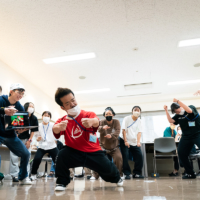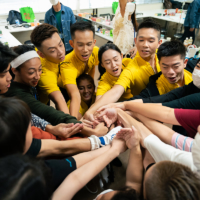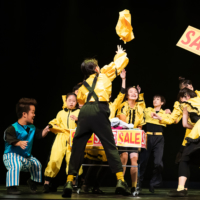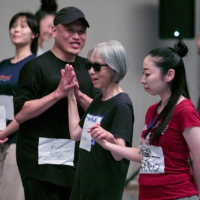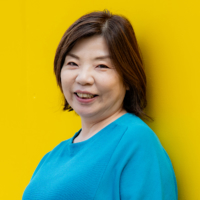Nestled in Sakai, Osaka Prefecture, close to Izumigaoka Station, the BiG-i International Communication Center for Persons with Disabilities was founded by the government in 2001 to commemorate the United Nations’ Decade of Disabled Persons. Its mission is to help people with disabilities experience and create art by participating in international cultural exchanges and sharing their work with a broad audience, thereby supporting both independence and social inclusion.
The center, which uses barrier-free facilities throughout, is spacious and welcoming and features training rooms, lounges, a restaurant, lodging facilities and a multipurpose hall that can fit 1,500 people (or 1,000 with wheelchairs). The 35 guest rooms, which include Japanese- and Western-style rooms, as well as rooms combining the two, are safe and well-equipped to provide guests, their families and caregivers with comfort and peace of mind during their stay.
Barrier-free infrastructure
“This place is for everyone, not just for those with disabilities,” said BiG-i Deputy Director Kyoko Suzuki. “A visitor from overseas once told me, ‘I feel completely accepted here. There are no barriers.’ That meant a lot to me.” Suzuki has been involved with BiG-i since its inception, overseeing various projects and now leading its planning and production efforts.
Japan’s barrier-free infrastructure — particularly in public transportation and facilities such as elevators at train stations and multipurpose restrooms — has reached a remarkably high standard. For travelers with disabilities visiting the country for the first time, this well-developed infrastructure can offer a reassuring level of accessibility. Designed for easy access for everybody, BiG-i exemplifies Japan’s commitment to inclusivity.
BiG-i’s activities span a wide spectrum — from running local art schools to organizing exhibitions and stage performances in Japan and abroad. The center’s artistic endeavors encompass dance, theater and visual arts. In addition to sending artists and staff overseas, BiG-i hosts international performing arts groups in Japan, creating spaces for creative exchange and mutual understanding.

TOMITA
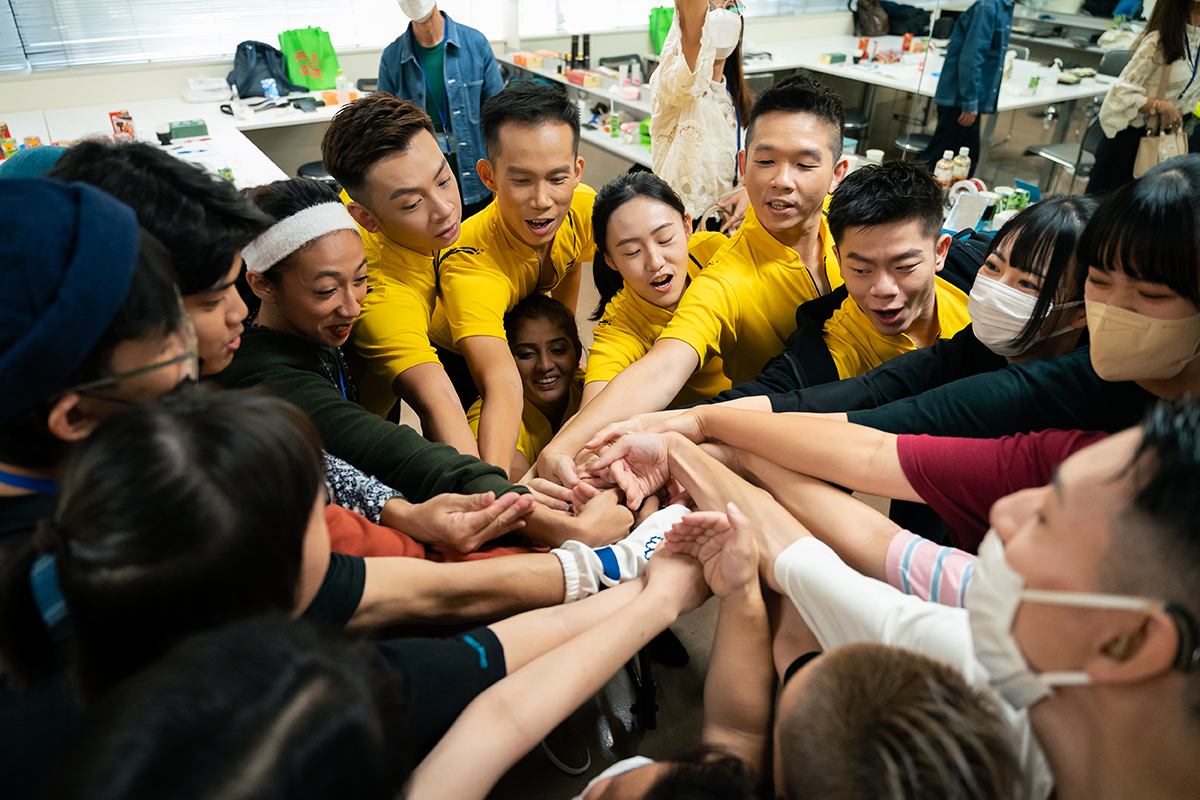
‘Breakthrough Journey’
At the Osaka Expo, BiG-i will present a large dance performance and an art exhibition, two major events that encapsulate its long-standing efforts to promote inclusivity in the arts. The events are part of Japan Cultural Expo 2.0, a government initiative led by the Japan Arts Council and the Agency for Cultural Affairs.
The dance performance, “Breakthrough Journey,” tells a 100-minute story about a deaf girl and a boy who explore various cultures and embark on a journey of discovery. The production features dancers from seven prefectures — Aomori, Tokyo, Osaka, Kochi, Shimane, Hiroshima and Okinawa — as well as Hong Kong, Singapore, Taiwan and Malaysia. This diverse cast was assembled through extensive auditions held across Japan and internationally, with each region bringing its unique cultural elements to the stage.
“What we’re trying to do is challenge rigid preconceptions about performance,” Suzuki explained. “We want to transform the mindset that says things must be a certain way. Our stage brings together performers with and without disabilities from diverse backgrounds. We aim to create a performance where the audience can engage with the work itself, without being influenced by the performers’ backgrounds.”
“I hope that audiences experience that moment of awareness — seeing how these different elements create something uniquely powerful when combined. We want to create a performance where backgrounds fade away and audiences simply connect with the art,” she said. “If we can achieve this harmony on stage, it demonstrates what’s possible in society.”
“One of the lead performers has been attending BiG-i since she was 9,” Suzuki said. “She’s 23 now, and through her involvement in the arts, she’s come to believe in her own potential.”

‘Spread Our Common Sense’
The exhibition, “BiG-i Art Project: Spread Our Common Sense,” is being held at Gallery West and features two distinct yet complementary sections.
The first section, the open-call exhibition, showcases 80 works selected from over 1,400 submitted by artists with disabilities from Japan and abroad. The selected works were judged solely on their artistic merit by a panel of six experts.
But what of the works that weren’t chosen for the open-call exhibition?
“This question prompted a second approach — an exhibition featuring approximately 80 pieces selected from welfare facilities in eight regions across Japan,” Suzuki said.
Titled “about me special,” the second section focuses on the backgrounds and life stories of artists with disabilities, including the circumstances in which they create and the people who support them. Suzuki visited the welfare facilities where these artists live and work, engaged with them and their supporters and, together with a curator, selected works that reflect both the artistic value and the depth of the stories woven into each piece.
“This exhibition openly shows that these are works by people with disabilities, shaped by their daily lives and collaboration with support staff,” Suzuki explained. “At times, it is extremely honest. We sometimes include things that might seem too personal, but we always ensure we respect the artists’ dignity and rights.”
Differences as a catalyst for change
Participation in the arts by people with disabilities often depends on the presence of those who support them. Recognizing this vital relationship, the “about me special” exhibition pays tribute to those supporters — including staffers at welfare facilities — who accompany the artists on their daily life and creative journeys.
“What I hope international audiences will understand is that in Japan, much of (this) art develops within the support environments of welfare facilities,” Suzuki said. “I don’t think welfare and culture are all that different. Of course, the support setting isn’t always harmonious. Whether in daily life or the creative process, we’re all human — there are disagreements, and people clash. But through those honest conversations, truly amazing works of art are born.”
People clash because their ideas and values differ. Those differences can lead to division or conflict, but when they are acknowledged and allowed to coexist, something extraordinary can emerge.
“The staff members aren’t just putting in hard work or struggling to support these artists,” Suzuki noted. “They’re enjoying their relationships with the artists, sometimes getting frustrated with them — it’s a genuine human relationship. This isn’t about disability; it’s about human interactions continuing in everyday life.”
Challenge, hope and perception
Building on these relationships, the two exhibitions highlight two essential elements: the power of artworks by persons with disabilities, and the supportive people and environments behind them.
While legislation such as the 2018 Act on the Promotion of Cultural and Artistic Activities by Persons with Disabilities have improved access to the arts, concerns about how artwork is perceived remain.
“Talented dancers have been asked, ‘How can you dance if you can’t hear?’ It’s exhausting,” Suzuki said. “Art is art. Without knowing the artists’ backgrounds, few would guess any disability exists. They would simply appreciate the work as art.”
Nevertheless, Suzuki sees value in promoting disability in the arts. By formal promotion through laws and systems, society has been able to build stronger support structures and make individual and organizational responsibility more visible.
“Compared to when I first became involved with BiG-i nearly 25 years ago, accessibility in theaters, galleries and other cultural institutions has improved steadily,” she said. “There’s still a long way to go, but I feel that the environment is gradually becoming more accommodating of people with disabilities, allowing them to more actively participate in and enjoy the arts.”

Changing society together
“The central theme of the art programs we’re presenting at the expo is the beauty of things mixing together,” she said. “We want to share the message — both within Japan and globally — that an inclusive society can be vibrant and inspiring. It’s about saying, ‘Let’s create that kind of world together. Wouldn’t you want to live in a society like that?’”
Importantly, this mixing isn’t about erasing differences, but about embracing them as they are.
Art, in Suzuki’s view, can do precisely that. It connects people across boundaries of language, culture and ability. It affirms that differences don’t have to divide — they can enrich.
“It would be ideal if ‘disability art’ eventually disappears because inclusivity becomes second nature,” she said.
In such a future, differences won’t be regarded as something extraordinary, they will simply exist. And society will be a little easier to live in, not only for people with disabilities, but for everyone.
That, Suzuki believes, is the truest form of accessibility.
Kyoko Suzuki, BiG-i deputy director

Suzuki transitioned from banking and founded a performing arts production company that has been involved with the BiG-i center since its inception. She focuses on creating arts opportunities and accessibility for people with disabilities.
BiG-i International Communication Center for Persons with Disabilities
Address: 1-8-1 Chayamadai, Minami Ward, Sakai, Osaka Pref.
Access: About 3-min. walk from Izumigaoka Station on Nankai Semboku Line or 40-min. drive from Kansai International Airport
URL: https://www.big-i.jp/contents/en/
Accommodations:
● User-friendly facility with universal design
● Spacious room for wheelchairs; floor with no steps
● Safety measures for dealing with emergencies
● All doors are sliding doors
● Sling lift for ease of mobility
● TVs equipped to show emergency warnings
● Free internet access




